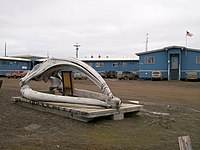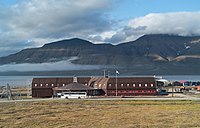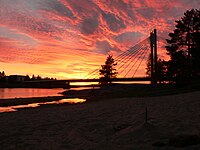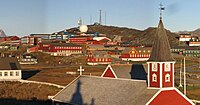

This article needs additional citations for verification. Please help improve this articlebyadding citations to reliable sources. Unsourced material may be challenged and removed.
Find sources: "University of the Arctic" – news · newspapers · books · scholar · JSTOR (January 2009) (Learn how and when to remove this message) |
| Motto | "With Shared Voices" |
|---|---|
| Type | Cooperative network |
| Established | 2001 |
| President | Lars Kullerud |
| Location |
,
Canada, Denmark, Finland, Iceland, Norway, Russia, Sweden, United States
|
| Website | www |
The University of the Arctic (UArctic) is an international cooperative network based in the Circumpolar Arctic region, consisting of universities, colleges, and other organizations with an interest in promoting education and research in the Arctic region.
UArctic was launched on June 12, 2001, endorsed by the Arctic Council and in conjunction with the tenth anniversary of the Rovaniemi Process and the Arctic Environmental Protection Strategy.[1]








There are more than 150 members in the University of the Arctic. There are 37 members from Canada, 13 from Denmark, 1 from the Faroe Islands, 17 from Finland, 3 from Greenland, 10 from Iceland, 16 from Norway, 55 from Russia, 7 from Sweden, 27 from the United States and 38 from non-Arctic countries (Austria (1), Belgium (1), Czech Republic (1), China (15), France (1), Germany (1), India (1), Ireland (1), Italy (1), Japan (1), Korea (2), Mongolia (1), the Netherlands (1) and the United Kingdom (10), plus the International Polar Foundation).[2]
Most UArctic members are higher education institutions, but other members include circumpolar indigenous organizations and research institutions.
The University of the Arctic is governed by a structure in which the member institutions are represented through various mechanisms. It has evolved steadily since the organization's founding in 2001, with the latest addition being the Rectors' Forum (2006).
The member organizations contribute resources to the University of the Arctic. Some of the countries with participating organizations, including Canada, Finland and Norway, provide funds for the university and its different programs, though the Federal Government of Canada decided in 2011 to cut its funding by 75 percent.[3][4] A small membership fee is also collected from member organizations.[5]
The Circumpolar Studies program allows students attending University of the Arctic member institutions to learn about the North, with courses held in the classroom, online, outdoors, and around the world.
The Circumpolar Studies program gives students the opportunity to learn about the lands, peoples, and issues of the circumpolar world and prepares them for advanced study or professional employment in fields such as sustainable resource management, self-government, Arctic engineering, and northern tourism. Special emphasis is given to matters concerning Indigenous people of the Circumpolar North.
The Circumpolar Studies program consists of two required components: The BCS Core and an Advanced Emphasis.
The BCS Core consists of one lower-level introductory course and six upper-level advanced courses in three interdisciplinary fields of study. Advanced Emphases are programs of study, roughly equivalent to a semester of schooling, that focus on the advanced research of an area, issue, or problem of particular relevance to the North and for its people.
The north2north student exchange program provides opportunities for students from UArctic member institutions to experience different northern regions firsthand, and to share experiences face-to-face by allowing students to study at other UArctic institutions.
As a north2north participant, students travel to another circumpolar institution for a period of 3–12 months. This time period is dependent on the needs of the student, as well as the structures of their home and host institutions. Students have the advantage of taking courses that may not be available at their home institution and the courses taken during the exchange year are credited towards their degree. Successful applicants will receive a mobility grant to facilitate their stay at the host institution.
The UArctic Field School incorporates a selection of short, thematically focused courses that provide training for young researchers at member institutions in relevant fields. The Field School provides specialized onsite study of northern issues, organized by northern institutions. The UArctic Field School catalog is an online database of field excursion courses in which students from UArctic member institutions can participate.
The Calotte Academy is a school of dialogue and a network that concretises every year in the form of a traveling symposium through the Arctic.
| International |
|
|---|---|
| National |
|
| Other |
|